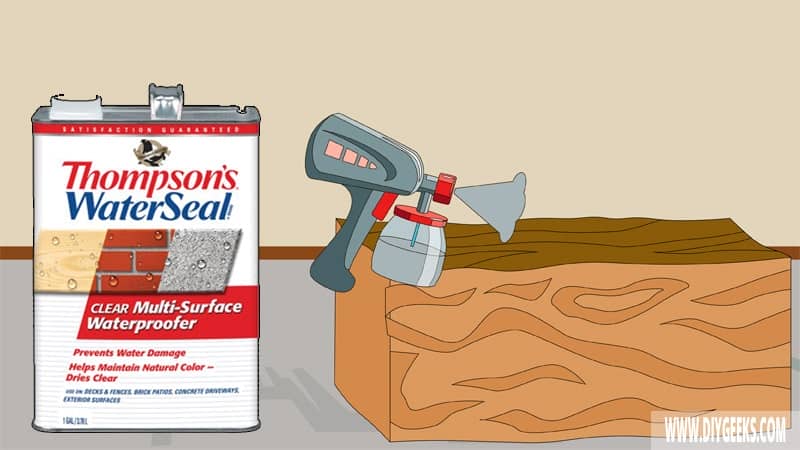You can apply Thompson’s water seal over stained wood to protect it from water damage and mold growth.
To apply Thompson’s water sealer over stained wood, prep the work area, clean the finish, sand the wood, and apply the Thompson’s water sealer.
Thompson’s WaterSeal is a sealer that protects surfaces from water damage, while wood stain is a finish that enhances the wood color and highlights the grain but doesn’t protect it.
You don’t need to remove wood stain before applying the sealer unless the finish is sealed. Wait 24-48 hours for the wood stain to dry before applying the Thompson’s Water Sealer.
Do You Need To Remove Wood Stain Before Applying Thompson’s Water Sealer?
You don’t need to remove wood stain before applying Thompson’s water sealer. Thompson’s water sealer is a topcoat and will stick over a finish as long as it’s cleaned and sanded.
However, you must remove the wood stain if it’s sealed with another topcoat, such as polyurethane, varnish, or gel stain. Topcoats produce a water-resistant coating and prevent another sealer (topcoat) from sticking.
Waterproof sealed wood stains, especially oil-based, don’t accept a topcoat properly. A new sealer won’t stick directly over a waterproof finish, even if it does it will chip or peel off later.
If the existing topcoat is water-based, sand it off with medium-grit sandpaper and apply a new topcoat.
How To Apply Thompson’s Water Sealer Over Stained Wood?
To apply Thompson’s water sealer over stained wood, do the following.
- Prep the Work Area.
- Clean the Finish.
- Sand the Wood.
- Apply the Thompson’s Water Sealer.
The tools you need for this project are listed below.
- Thompson’s water seal
- An airless paint sprayer
- Sandpaper of different grits
- Masking tape
- Microfiber cloth
- A pair of gloves
- Denatured alcohol
- Drop sheets
1. Prep the Work Area

Prep the work area by removing or covering the objects and items near the wooden surface.
2. Clean the Finish

Clean the stained wood with a damp rag to remove dust, debris, or dirt that can show once the Thompson’s water sealer dries.
If the stained wood is already sealed, use coarse-grit sandpaper (40-grit) to remove the sealer coating before applying Thompson’s water sealer.
To know if the wood is sealed, pour water over the finish. If the water absorbs the stained wood, the finish isn’t sealed. The finish is sealed if water can’t penetrate the wooden surface.
3. Sand the Wood

Sand the stained wood with fine-grit sandpaper (220-grit) to remove surface imperfections and bumps, and make the finish smooth. Don’t use coarse or medium-grit sandpaper as it can remove the entire finish.
Prep the Thompson’s water sealer by following the manufacturer’s instructions.
4. Apply the Thompson’s Water Sealer

Apply two (2) thin Thompson’s water sealer coats over the stained wood using a paintbrush, roller, or sprayer. Wait until one coat dries, sand between coats, and apply the next coat.
How Long Must Wood Stain Dry Before Thompson’s Water Sealer?
Water-based wood stain must cure for around 24 hours, while oil-based wood stain must cure (dry fully) for around 48-72 hours before applying Thompson’s water sealer.
The exact dry and cure time depends on the wood stain type (oil or water-based), the thickness of the coat, room temperature, and humidity levels.
The wood stain solvent (oil or water) must evaporate from the coating, and the coating must polymerize before you can seal it.
The finish will turn sticky, peel off, or remain wet for longer if you seal it too soon as the solvent will get trapped between the wood stain and Thompson’s water sealer.
The solvent will prevent the existing coating from drying, and prevent the sealer from sticking. That’s why you must wait until a finish is fully dry (cured) before sealing it.
When wood is damp (wet), you can apply a sealer as the moisture in the wood can’t affect or prevent it from sticking. But, a wet wood stain doesn’t contain just water (moisture), it also contains oils, pigments, binders, and other additives.
Some of these additives can prevent a sealer from sticking, so you must wait until all of them evaporate and the coating becomes hard before sealing it.
How To Know Which Stained Wood Needs Sealing?
Outdoor stained woods need sealing as wood stain doesn’t protect them from outdoor elements. Indoor-stained woods don’t need a sealer unless they are exposed to constant water.
Wood stain enhances the color of the surface and highlights the grain, but doesn’t protect it. On the other hand, a sealer produces a glossy moisture-resistant layer that protects the surface underneath from water, moisture, and other elements.


